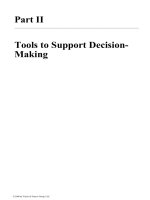Financial accounting 8e tool for busniess decision making chapter 05
Bạn đang xem bản rút gọn của tài liệu. Xem và tải ngay bản đầy đủ của tài liệu tại đây (2.83 MB, 86 trang )
5-1
5
Merchandising Operations and the
Multiple-Step Income Statement
Kimmel ● Weygandt ● Kieso
Financial Accounting, Eighth Edition
5-2
CHAPTER OUTLINE
LEARNING OBJECTIVES
5-3
1
Describe merchandising operations and inventory systems.
2
Record purchases under a perpetual inventory system.
3
Record sales under a perpetual inventory system.
4
Prepare a multiple-step income statement and a
comprehensive income statement.
5
Determine cost of goods sold under a periodic inventory
system.
6
Compute and analyze gross profit rate and profit margin.
LEARNING
OBJECTIVE
1
Describe merchandising operations and
inventory systems.
Merchandising Companies
Buy and Sell Goods
Retailer
Wholesaler
Consumer
The primary source of revenues is referred to as
sales revenue or sales.
5-4
LO 1
Merchandising Company
Income Measurement
Sales
Revenue
Less
Cost of
Goods Sold
Not used in a
Service business.
Equals
Gross
Profit
Cost of goods sold is the total
cost of merchandise sold
during the period.
5-5
ILLUSTRATION 5-1
Income measurement process for a
merchandising company
Less
Operating
Expenses
Equals
Net
Income
(Loss)
LO 1
OPERATING CYCLES
5-6
ILLUSTRATION 5-2
Operating cycles for a
service company and a
merchandising company
LO 1
FLOW OF COSTS
ILLUSTRATION 5-3
Flow of costs
Companies use either a perpetual inventory system or a
periodic inventory system to account for inventory.
5-7
LO 1
FLOW OF COSTS
Perpetual System
5-8
Maintain detailed records of the cost of each inventory
purchase and sale.
Records continuously show inventory that should be
on hand for every item.
Company determines cost of goods sold each time a
sale occurs.
LO 1
FLOW OF COSTS
Periodic System
Do not keep detailed records of the goods on hand.
Cost of goods sold determined by count at the end of
the accounting period.
Calculation of Cost of Goods Sold:
Beginning inventory
$ 100,000
Add: Purchases, net
800,000
5-9
Goods available for sale
LO 1
FLOW OF COSTS
Advantages of the Perpetual System
5-10
Traditionally used for merchandise with high unit
values.
Shows the quantity and cost of the inventory that
should be on hand at any time.
Provides better control over inventories than a
periodic system.
LO 1
INVESTOR INSIGHT
Morrow Snowboards, Inc.
Improve Stock Appeal
Investors are often eager to invest in a company that has a hot
new product. However, when snowboard maker Morrow
Snowboards, Inc. issued shares of stock to the public for the
first time, some investors expressed reluctance to invest in
Morrow because of a number of accounting control problems. To
reduce investor concerns, Morrow implemented a perpetual
inventory system to improve its control over inventory. In
addition, it stated that it would perform a physical inventory count
every quarter until it felt that its perpetual inventory system was
reliable.
5-11
LO 1
DO IT!
1
Merchandising Operations and
Inventory Systems
Indicate whether the following statements are true or false. If false,
indicate how to correct the statement.
1. The primary source of revenue for a
merchandising company results from performing
services for customers.
5-12
False
(service
company)
2. The operating cycle of a service company is
usually shorter than that of a merchandising
company.
True
3. Sales revenue less cost of goods sold equals
gross profit.
True
4. Ending inventory plus the cost of goods
purchased equals cost of goods available for sale.
False
(Beg. Inventory
+ COGS)
LO 1
LEARNING
OBJECTIVE
2
Record purchases under a perpetual
inventory system.
Made using cash or
credit (on account).
Normally record when
goods are received
from the seller.
Purchase invoice
should support each
credit purchase.
5-13
ILLUSTRATION 5-5
Sales invoice used as
Purchase invoice by Sauk Stereo
LO 2
Record Purchase of Merchandise
ILLUSTRATION 5-5
Illustration: Sauk Stereo (the
buyer) uses as a purchase
invoice the sales invoice
prepared by PW Audio Supply,
Inc. (the seller). Prepare the
journal entry for Sauk Stereo
for the invoice from PW Audio
Supply.
May 4
5-14
Inventory
Accounts Payable
3,800
3,800
LO 2
FREIGHT COSTS
Ownership of the goods
passes to the buyer when the
public carrier accepts the
goods from the seller.
ILLUSTRATION 5-6
Shipping terms
Ownership of the goods
remains with the seller until
the goods reach the buyer.
Freight costs incurred by the seller are an operating expense.
5-15
LO 2
FREIGHT COSTS
Illustration: Assume upon delivery of the goods on May 6,
Sauk Stereo pays Public Freight Company $150 for freight
charges, the entry on Sauk Stereo’s books is:
May 6
Inventory
150
Cash
150
Assume the freight terms on the invoice in Illustration 5-5 had
required PW Audio Supply to pay the freight charges, the
entry by PW Audio Supply would be:
May 4
5-16
Freight-out
Cash
150
150
LO 2
PURCHASE RETURNS AND ALLOWANCES
Purchaser may be dissatisfied because goods are
damaged or defective, of inferior quality, or do not meet
specifications.
5-17
Purchase Return
Purchase Allowance
Return goods for credit if
the sale was made on
credit, or for a cash refund
if the purchase was for
cash.
May choose to keep the
merchandise if the seller
will grant a reduction of the
purchase price.
LO 2
PURCHASE RETURNS AND ALLOWANCES
Illustration: Assume Sauk Stereo returned goods costing
$300 to PW Audio Supply on May 8.
May 8
Accounts Payable
Inventory
5-18
300
300
LO 2
PURCHASE RETURNS AND ALLOWANCES
Review Question
In a perpetual inventory system, a return of defective
merchandise by a purchaser is recorded by crediting:
a. Purchases
b. Purchase Returns
c. Purchase Allowance
d. Inventory
5-19
LO 2
PURCHASE DISCOUNTS
Credit terms may permit buyer to claim a cash discount
for prompt payment.
Example: Credit terms
Advantages:
may read 2/10, n/30.
5-20
Purchaser saves money.
Seller shortens the operating cycle by converting the
accounts receivable into cash earlier.
LO 2
PURCHASE DISCOUNTS
5-21
2/10, n/30
1/10 EOM
n/10 EOM
2% discount if
paid within 10
days, otherwise
net amount due
within 30 days.
1% discount if
paid within first 10
days of next
month.
Net amount due
within the first 10
days of the next
month.
LO 2
PURCHASE DISCOUNTS
Illustration: Assume Sauk Stereo pays the balance due of
$3,500 (gross invoice price of $3,800 less purchase returns
and allowances of $300) on May 14, the last day of the
discount period. Prepare the journal entry Sauk Stereo
makes on May 14 to record the payment.
May 14
Accounts Payable
Inventory
3,500
70
Cash
3,430
(Discount = $3,500 x 2% = $70)
5-22
LO 2
PURCHASE DISCOUNTS
Illustration: If Sauk Stereo failed to take the discount, and
instead made full payment of $3,500 on June 3, the journal
entry would be:
June 3
Accounts Payable
3,500
Cash
3,500
5-23
LO 2
PURCHASE DISCOUNTS
Should discounts be taken when offered?
Example: 2% for 20 days = Annual rate of 36.5%
($3,500 x 36.5% x 20) ÷ 365 = $70
5-24
LO 2
PURCHASING TRANSACTIONS
4th - Purchase
$3,800
$300
6th – Freight-in
150
70
8th - Return
14th - Discount
Balance
$3,580
5-25
LO 2









